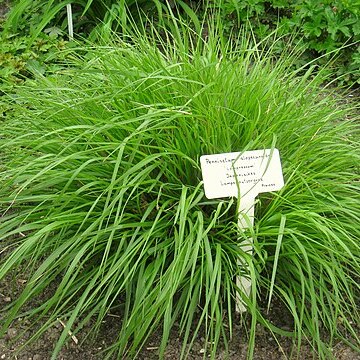Coarse grey-green tussocks of medium size, with narrow wiry leaves; branching intravaginal. Leaf-sheath hard, strongly keeled, glabrous, shining, brownish or often pinkish, margins membranous. Ligule 0.3-0.6 mm, a densely, shortly ciliate rim. Leaf-blade 15-30 cm × 1-1.5 mm diam., folded or involute, sometimes flat, linear, long-tapering, abaxially glabrous, adaxially often shallowly ribbed, ribs minutely scabrid, occasionally with a few soft hairs near ligule; margins minutely scabrid, tip acuminate. Culm 20-40 cm, erect, rounded or ± compressed, internodes loosely covered by fine, long, soft hairs near panicle. Panicle 7-12 cm, spike-like, cylindric, purplish; rachis and ± appressed branches and pedicels soft-hairy. Spikelets 5.5-6.5 mm, shortly pedicelled, densely clustered on rachis, narrow-lanceolate, acute, light creamy brown, minutely scabrid, greenish below, deep purple-brown towards apex, usually solitary within a much longer involucre of numerous, fine, erect, short-scabrid unequal bristles (15-25 mm), united at base; rarely 2 spikelets within involucre. Glumes « spikelet, unequal, submembranous; lower 0.5-1 mm, varying from nerveless, ± cuneate or rimlike, to longer-lanceolate, 1-nerved, upper 2-3 mm, c. ⅓ length of spikelet, faintly 5-(7)-nerved. Lower floret Ø: lemma 5-6 mm, ≈ spikelet, submembranous, 7-nerved, almost enclosing lemma of upper floret; palea 0. Upper floret ☿: lemma 5.5-6.5 mm, somewhat chartaceous, 5-7-nerved, ± enclosing palea; palea similar to lemma but slightly shorter, slightly rounded, nerves 2, glabrous; lodicules 0.2-0.5 mm; anthers 2.7-3.5 mm; styles connate below feathery stigmas, or sometimes partly or wholly free; caryopsis c. 2-2.5 × 1 mm, dark brownish.
More
Perennial forming dense tussocks. Culms stout, 30–120 cm tall, hispid below inflorescence. Leaf sheaths papery, keeled, imbricate at culm base; leaf blades linear, flat or often involute, 10–80 × 0.3–1 cm, base papillose-hispid, apex long acuminate; ligule 0.5–2.5 mm. Inflorescence linear, 5–25 × 1.5–3.5 cm; axis hispid, peduncle stumps short with crateriform tips; involucre usually enclosing one spikelet, rarely 2, basal stipe (1–)2–3 mm; bristles greenish or purple, longest 2–3 cm but not conspicuously longer than the others, all slender, hispid. Spikelet lanceolate, 5–8 mm; lower glume 0.6–3 mm, 0–1-veined, obtuse; upper glume ovate-lanceolate, 1/3–2/3 as long as spikelet, 3–5-veined; lower lemma as long as spikelet, 7–11-veined; upper lemma lanceolate, as long as spikelet, papery, acuminate; anthers usually glabrous, occasionally with 1 or 2 hairs at tip. Fl. and fr. summer and autumn. 2n = 18.
An evergreen grass. It grows 60-120 cm high and wide. It forms a clump or mound. The leaves are narrow and arching. They are 0.6-1 m long and 0.6 cm wide. They are dark green. They are hairy along the edges. The flower heads are fuzzy and purple. They are 7-20 cm long by 2-3 cm wide. They weigh down the stem tips. The flower stems are 1 m long.

